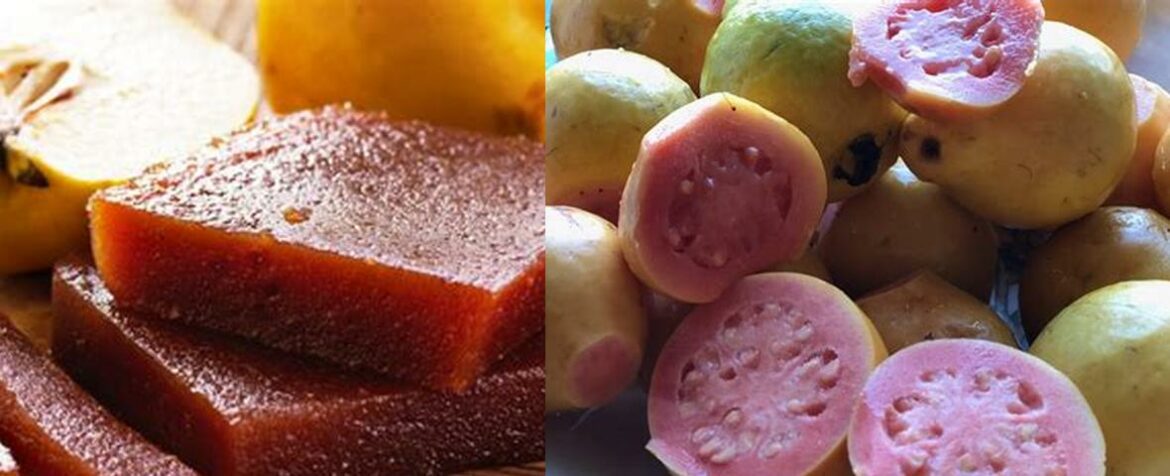Membrillo O Guayaba – When it comes to fruits, there are some that steal the spotlight with their vibrant colors and sweet flavors. And in the world of Spanish cuisine, two fruits take center stage: Membrillo and Guayaba. These fruits are not only delicious, but they also have fascinating stories to tell. So, whether you’re a fruit enthusiast or just looking to add some excitement to your culinary adventures, join us as we explore the tale of these two fruits. Get ready to dive into the juicy world of Membrillo and Guayaba!
Membrillo and Guayaba: A Tale of Two Fruits
In the vast world of fruits, membrillo and guayaba stand out with their distinctive flavors, nutritional benefits, and culinary versatility. While both belong to the same family (Myrtaceae), these fruits offer unique experiences, whether enjoyed raw, cooked, or transformed into delectable creations.
Membrillo: A Spanish Delicacy
Hailing from the sunny regions of Spain, membrillo is a culinary treasure crafted from the humble quince fruit. This unique delicacy undergoes a meticulous cooking process, where the quince is simmered in sugar and water until it transforms into a thick, sticky paste, capturing the essence of this remarkable fruit.
In its raw form, membrillo possesses a bitter and grainy texture, a stark contrast to its cooked counterpart. Once transformed by the heat, it takes on a soft and intensely flavored persona, a testament to the alchemy of culinary arts.
Membrillo’s distinct flavor profile is a symphony of sweetness and tartness, reminiscent of a harmonious blend between apples and pears. Its rich yellow hue and rough texture add visual intrigue to any dish, inviting both the eyes and the palate to embark on a culinary adventure.
Guayaba: A Tropical Delight
Native to the vibrant lands of Central and South America, guayaba, also known as guava, is a tropical fruit that captivates with its vibrant green or yellow skin and creamy white or pink flesh. Its sweet flavor and high nutritional value have earned it a prominent place in kitchens and hearts across the globe.
Guayaba’s versatility shines in the culinary realm, where it seamlessly transitions from a standalone treat to a key ingredient in jams, jellies, candies, and beverages. Its tropical essence adds a burst of flavor to desserts, pies, and ice creams, transforming ordinary creations into extraordinary delights.
Beyond its culinary charm, guayaba holds a wealth of nutritional treasures. It is a rich source of vitamin C, a potent antioxidant that bolsters the immune system and safeguards against various ailments. Moreover, its high fiber content promotes digestive health, while its ability to regulate blood sugar levels and prevent cancer makes it a true ally for well-being.
A Culinary Comparison: Membrillo versus Guayaba
While both membrillo and guayaba share the stage as delectable fruits, they possess distinct characteristics that set them apart.
Membrillo’s tart and slightly sweet flavor profile stands in contrast to guayaba’s pronounced sweetness, reminiscent of pineapple or mango, interwoven with subtle floral undertones. Their textures also diverge, with membrillo’s waxy exterior and grainy flesh contrasting with guayaba’s soft flesh and small seeds.
In terms of preparation, membrillo requires peeling before consumption, while guayaba’s skin is edible, though its seeds need to be removed. This difference in preparation adds another layer of distinction between these two fruits.
Culinary Explorations: Unlocking the Potential of Membrillo and Guayaba
Membrillo and guayaba’s unique flavors and textures lend themselves to a myriad of culinary adventures.
Membrillo’s versatility shines in jams, jellies, and pastes, where its distinct flavor takes center stage. It can also be sliced and served atop cheese or enjoyed as a sweet snack, offering a delightful balance of flavors.
Guayaba’s tropical essence finds its haven in desserts, where it transforms pies and ice creams into culinary masterpieces. Its sweet flavor and vibrant color add a touch of exotic elegance to any creation.
Conclusion: Embracing the Diversity of Membrillo and Guayaba
Membrillo and guayaba, two distinct fruits with unique characteristics, offer a world of culinary possibilities. Whether you prefer the tart sweetness of membrillo or the tropical allure of guayaba, these fruits are sure to tantalize your taste buds and inspire your culinary creativity.
So, embark on a culinary journey with membrillo and guayaba, explore their diverse flavors and textures, and discover the endless possibilities that await in the world of these remarkable fruits.
FAQ about Membrillo and Guayaba
Q: What does membrillo taste like?
A: Membrillo has a distinct flavor profile that combines sweetness and tartness, similar to a blend of apples and pears.
Q: What are some culinary uses for membrillo?
A: Membrillo is versatile and can be used in jams, jellies, and pastes. It can also be sliced and served with cheese or enjoyed as a sweet snack.
Q: How does guayaba differ from membrillo in terms of flavor?
A: Guayaba has a pronounced sweetness, reminiscent of pineapple or mango, with subtle floral undertones. It is sweeter compared to the tartness of membrillo.
Q: What are some popular ways to use guayaba in cooking?
A: Guayaba is often used in desserts, where it can transform pies and ice creams into culinary masterpieces. Its sweet flavor and vibrant color add an exotic touch to creations.
Q: How do the textures of membrillo and guayaba differ?
A: Membrillo has a rough texture with a waxy exterior and grainy flesh. Guayaba, on the other hand, has a soft flesh and small seeds.
Q: Can membrillo and guayaba be used together in recipes?
A: Yes, membrillo and guayaba can be used together in recipes to create unique flavor combinations. Their distinct characteristics can add depth and complexity to culinary creations.


